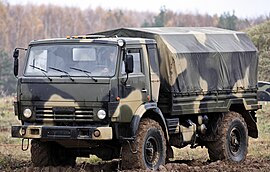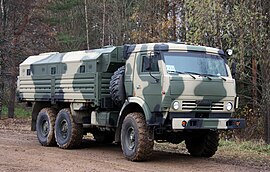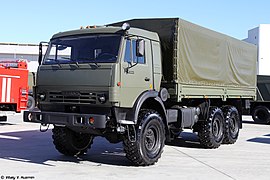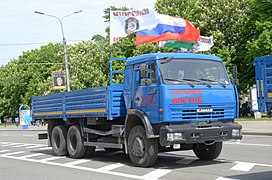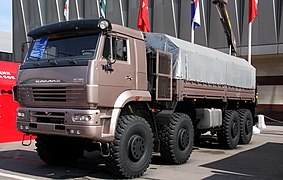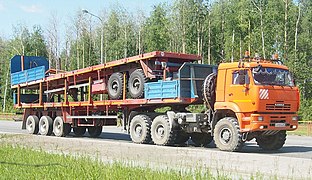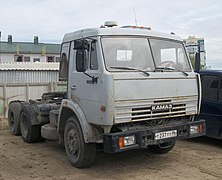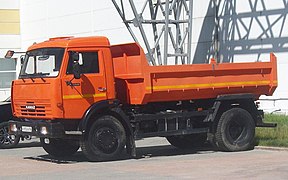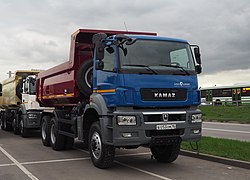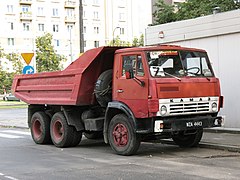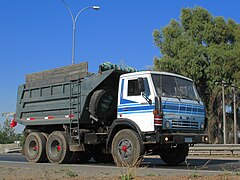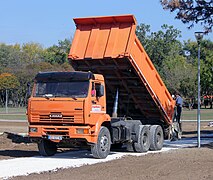KAMAZ
Coordinates: 55 ° 44 ′ 49.6 " N , 52 ° 26 ′ 46.3" E
| КАМАЗ KAMAZ |
|
|---|---|
| legal form | Corporation |
| ISIN | RU0008959580 |
| founding | 1969 |
| Seat | Naberezhnye Chelny |
| management | Sergei A. Kogogin |
| Number of employees | approx. 36,000 (2016) |
| sales | 56.6 billion Russian rubles (2012) |
| Branch | vehicle construction |
| Website | www.kamaz.ru |
The Russian company KAMAZ ( Russian ПАО КАМАЗ , German officially KAMAZ AG , are abbreviated for Камский автомобильный завод or Kamski awtomobilny zavod ), as a result formerly standardized reference numbers KamAZ known, is located in the industrial city of Naberezhnye Chelny , Russia . In addition to trucks , the automobile plant also produces diesel engines , buses ( NefAZ - НефАЗ) and tanks .
Nearby is the Kama dam, which regulates the Kama in the form of the Nizhnekamsk reservoir and supplies the region with electrical energy with the help of the integrated hydropower plant.
history
Soviet time
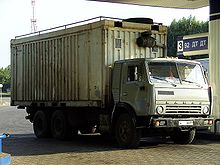

In the mid-1960s, there was a high demand for medium-weight trucks in the Soviet Union that could not be met from its own production. For this reason, a complete production plant was put into operation in 1976, which was built within five years. 70% of the machines required for this had to be imported. The optimal production site determined by computer analysis was Naberezhnye Chelny. The production complex now includes ten large special plants with a capacity of up to 65,000 trucks, 1,000 buses and up to 75,000 diesel engines per year. This made the KAMAZ plants one of the largest commercial vehicle manufacturers in the world.
Before the mass production began, 24 prototypes were built in the Moscow engineering institute I. A. Lichatschow , which were projected in the central Soviet vehicle planning and development institute NAMI and tested for their suitability for everyday use and robustness in various Soviet climatic areas such as Siberia , Urals and the hot southern Union republics . The engines were developed centrally in the Jaroslawski Motorny Sawod . The test samples looked different than the later series trucks , especially in terms of the cab design . Three prototypes went into production initially. A flatbed truck (model KamAZ-5320 ), a tractor unit ( KamAZ-5410 ) and a dump truck ( KamAZ-5511 ) - all as three-axle variants.
The first KAMAZ series truck rolled off the assembly line on February 16, 1976, and large-scale production began in 1977. This started exactly one week before the XXV. CPSU party congress series production. In the first year, 15,000 trucks in the 8 to 20 ton weight classes were produced by October 1976 and 22,000 by December. These trucks had 210 hp and later with a turbocharger 260 hp. The vehicles were very widespread in the entire Comecon area until the early 1990s . The engines were also supplied to other truck manufacturers such as ZIL , the Uralsky Avtomobilny Zavod and LiAZ . The plan was to produce 150,000 trucks and 250,000 engines per year. In February 1985, assembly production was set up in Cuba . Trucks were also built under the name Altkam . In October 1988 the one millionth truck rolled off the assembly line at the Naberezhnye Chelny plant. Production of the first two-axle vehicle, the KamAZ-5325, also began in 1988 .
On August 23, 1990, the company was the first in the Soviet Union to be converted into a joint stock company.
After the collapse of the Soviet Union
Cummins engines were used as early as 1992, and their own engines were also installed until 1995. On April 14, 1993, the engine factory was destroyed by a major fire. Now Cummins six-cylinder engines with up to 400 hp, a multi-fuel engine , Eaton transmissions and cabs from Sisu were used. The Friedrichshafen gear factory also supplied the gearbox and Rockwell the axles.
With the political upheavals in Eastern Europe, the framework conditions for production also changed. KAMAZ came to the brink of ruin in 1998 . In 1999 the company received more than $ 100 million in credit from the European Bank for Reconstruction and Development (EBRD). Despite the collapsed sales market, 1.5 million trucks were built up to August 1993 and a total of 1.6 million trucks up to August 1999. In 2000 only 5,000 trucks were added and Cummins and the Friedrichshafen gear factory stopped delivering. Orders now came from the Russian armed forces so that their own V8 engines could be installed in the trucks. The civil types now got Caterpillar engines. By 2003, a total of around 2.3 million own and third-party diesel engines had left the plant. The vehicles are still widespread in the CIS countries and, according to the factory, are exported to around 30 countries worldwide.
On December 12, 2008, Daimler AG acquired 10% of the KAMAZ shares from Troika-Dialog Holding. An increase to up to 43% of the stake is planned in the event of positive economic development. Daimler also has a seat on the supervisory board and has extensive influence on the further development and modernization of the model series.
In October 2009 it was announced that Daimler and KAMAZ want to work more closely together, a joint project is to be developed. Mercedes trucks are produced in a KAMAZ plant. Mercedes-Benz products and Setra- brand buses are also to be sold through the company . The service and sales network is to be expanded through KAMAZ dealers. Daimler's Japanese subsidiary Fuso will also build trucks in Naberezhnye Chelny. The Fuso Canter was named . The aim is to gradually increase the proportion of Russian suppliers and Russian-made components and to strengthen the overall presence of Mercedes-Benz and the cooperation with KAMAZ in Russia.
By 2014, Daimler had increased its stake in KAMAZ to 15%. Also as of 2014, the plant had produced 2.13 million trucks and 2.8 million diesel engines in its history.
A cooperation agreement was signed between Liebherr and KAMAZ on March 25, 2015 . It was agreed that Liebherr would not only develop modern diesel engines for KAMAZ, but also act as a technical advisor for the company. Since 2016, the company has been building a new generation of trucks around the KamAZ-6580 tipper in series, which was presented at vehicle fairs in 2015. In series production, engines from Mercedes-Benz and transmissions from ZF Friedrichshafen are installed in the vehicles . The trucks are the manufacturer's first series vehicles to meet the EURO 5 emissions standard.
The KAMAZ Group
The KAMAZ Group includes more than 110 subsidiaries and associated companies. Furthermore, KAMAZ is involved in around 50 companies. The group includes a .:
- the main plant in Naberezhnye Chelny , responsible for truck production
- the Neftekamski Avtosawod (abbreviated NefAZ) in Neftekamsk , production of buses, trailers and semi-trailers, special bodies, combination buses and agricultural equipment
- KAMAZ metallurgy
- Foundry and stamping plant
- KAMAZ Diesel
- KAMAZ Remdiesel
- KAMAZ technical service
- Commercial and financial company KAMAZ
- KIP Master
- Scientific and technical center of KAMAZ
- KAMAZ special instrument manufacture
Series models
truck
The Russian standard GOST ON 025270-66 from 1966, which contained the designation system of Soviet and Russian motor vehicles, was binding for model designations until 2003 . She prescribed numbers according to the scheme KamAZ-XXXX, e.g. B. KamAZ-5410. Today, the manufacturer also markets the vehicles as KAMAZ XXXX.
The current product range includes well over 200 different models based on KAMAZ trucks, from standard trucks to crane trucks and fire engines. In addition, there is a wide range of types from branch plants such as NefAZ, which manufacture special bodies and rely on KAMAZ chassis. The results are in turn managed as separate models. Below is a selection of the most important current and historical versions.
Platform trucks and chassis
- Two-axle with all-wheel drive
KamAZ-4326 (since 1995)
KamAZ-4350 (since 2003)
KamAZ-43501 (since 2003)
KamAZ-43502 (since 2008)
- Two-axle vehicle without all-wheel drive
KamAZ-4308 (since 2004)
KamAZ-43253 (since 2001)
KamAZ-5325 (1988-2003)
- Three-axle vehicle with all-wheel drive
KamAZ-4310 (1981-1995)
KamAZ-43114 (since 1995)
KamAZ-43118 (since 1995)
KamAZ-53228 (1989-2009)
KamAZ-5350 (since 2003)
KamAZ-53501 (since 2003)
KamAZ-65224 (since 2005)
- Three-axle vehicle without all-wheel drive
KamAZ-5320 (1976-2000)
KamAZ-53212 (1980-2002)
KamAZ-53215 (since 1995)
KamAZ-53229 (1995-2014)
KamAZ-65117 (since 2005)
- Four-axle with all-wheel drive
KamAZ-6350 (since 1998)
KamAZ-63501 (since 2004)
KamAZ-6560 (since 2005)
Tractor units
- Two-axle vehicle without all-wheel drive
KamAZ-5460 (since 2003)
- Three-axle vehicle with all-wheel drive
KamAZ-44108 (2001-2014)
KamAZ-65225 (since 2004)
- Three-axle vehicle without all-wheel drive
KamAZ-5410 (1976-2006)
KamAZ-54112 (1980-2006)
KamAZ-54115 (1995-2011)
KamAZ-6460 (since 2003)
KamAZ-65116 (since 2005)
Dump truck
- Two-axle vehicle without all-wheel drive
KamAZ-43255 (since 2007)
KamAZ-53605 (since 2005)
- Three-axle vehicle with all-wheel drive
KamAZ-45141 (since 2009)
KamAZ-6522 (since 2002)
KamAZ-65802 (since 2016)
- Three-axle vehicle without all-wheel drive
KamAZ-45143 (since?)
KamAZ-55102 (1980-1990)
KamAZ-5511 (1977-1990)
KamAZ-55111 (1988-2012)
KamAZ-65111 (since 2003)
KamAZ-65115 (since 1995)
KamAZ-6520 (since 2002)
- Four-axle vehicle without all-wheel drive
KamAZ-65201 (since 2002)
KamAZ-6540 (since 1996)
Production numbers
In the 2000s and 2010s, KAMAZ built an average of around 35,000 trucks per year, most of which over 80% were sold in Russia. The following table shows the sales figures for trucks between 8 and 40 tonnes gross vehicle weight.
| year | 2008 | 2009 | 2010 | 2011 | 2012 | 2013 | 2014 | 2015 | 2016 | 2017 | 2018 |
|---|---|---|---|---|---|---|---|---|---|---|---|
| Domestic sales | 36,600 | 22,100 | 28,500 | 39,600 | 40,200 | 38,300 | 32,600 | 22,600 | 28.3 | 33,100 | 37,000 |
| export | 11,300 | 3900 | 4000 | 6200 | 6300 | 5700 | 6100 | 5800 | 6200 | 5000 | 6100 |
| Total production | 47,900 | 26,000 | 32,500 | 45,800 | 46,500 | 44,000 | 38,700 | 28,500 | 34,500 | 38,200 | 43,100 |
As of April 2018, KAMAZ has produced more than 2.252 million trucks since it was founded and in the same year had a market share of around 45% in the heavy truck segment in Russia. The production capacity is around 71,000 vehicles per year.
Passenger cars
On December 21, 1987, KAMAZ began production of the Oka small car . It was marketed until March 16, 1990 under the brand name Kama and the model name 1111 . Up to this point in time 1,000 vehicles had been built. Then the marketing by Lada and SeAZ took place . Today KAMAZ no longer manufactures passenger cars.
Armored vehicles

KAMAZ produces various four- and six-axle armored vehicles for the Russian armed forces as well as for the police and border guards on the basis of its own chassis.
- KamAZ-43269 , respectively Spähpanzer armored cars as - BPM-97 designated
- KamAZ-63968 - protected military vehicle, from a typhoon-K referred
- KamAZ-63969 - protected military vehicle, a technically and visually modified version of the KamAZ-63968, built in series since 2013
buses
KAMAZ produces the KamAZ-5262 and KamAZ-5297 bus models. In 2016, the autonomous KamAZ-1221 Schatl minibus was presented at the Moscow International Automobile Salon .
Motorsport
The KAMAZ-master works team regularly takes part in the Dakar Rally with up to three T4 category vehicles. The overall truck ranking has been won 14 times so far, in the years 1996, 2000, 2002 to 2006, 2009 to 2011, 2013 to 2015 and 2017 to 2020. In some cases, Liebherr truck engines were used.
Victories at the Dakar Rally
| year | Driver (nationality) | Trucks | route |
|---|---|---|---|
| 1996 | Moskowskich, Kuzmin ( RUS ) | 1st place | Granada - Dakar |
| 2000 | Tschagin , Jakubow, Sawostin (RUS) | 1st place | Paris - Dakar - Cairo |
| 2002 | Tschagin, Jakubow, Sawostin (RUS) | 1st place | Arras - Madrid - Dakar |
| 2003 | Tschagin, Jakubow, Sawostin (RUS) | 1st place | Marseille - Sharm El Sheikh |
| 2004 | Tschagin, Jakubow, Sawostin (RUS) | 1st place | Clermont-Ferrand - Dakar |
| 2005 | Kabirow , Beljajew, Mokejew (RUS) | 1st place | Barcelona - Dakar |
| 2006 | Tschagin, Jakubow, Sawostin (RUS) | 1st place | Lisbon - Nouakchott - Dakar |
| 2009 | Kabirow, Beljajew, Mokejew (RUS) | 1st place | Buenos Aires - Buenos Aires |
| 2010 | Tschagin, Sawostin, Nikolajew (RUS) | 1st place | Buenos Aires - Antofagasta - Buenos Aires |
| 2011 | Chagin, Zavostin, Shaysultanov (RUS) | 1st place | Buenos Aires - Arica - Buenos Aires |
| 2013 | Nikolayev (RUS) | 1st place | Rosario - Santiago de Chile |
| 2014 | Karginow, Mokejew, Dewjatkin (RUS) | 1st place | Lima - Valparaiso |
| 2015 | Mardejew, Belyayev, Swistunow (RUS) | 1st place | Buenos Aires - Buenos Aires |
| 2017 | Nikolajew, Jakowlew, Rybakow (RUS) | 1st place | Asunción - Buenos Aires |
| 2018 | Nikolajew, Jakowlew, Rybakow (RUS) | 1st place | Lima - Cordoba |
| 2019 | Nikolajew, Jakowlew, Rybakow (RUS) | 1st place | Lima - Lima |
| 2020 | Karginow, Mokejew, Leonow (RUS) | 1st place | Saudi Arabia |

More Achievements
Rustam Minnichanow , the current President of Tatarstan , was an avid racing driver in his spare time and won the UAE Desert Challenge in the United Arab Emirates in 2002, 2003, 2004 and 2006 with a factory KamAZ-4911 truck . In 2005 he was unable to participate in this rally raid after a broken leg .
Rally vehicles
- KamAZ-4911 - two-axle rally truck
- KamAZ-49252 - two-axle rally truck
- KamAZ-49256 - two-axle rally truck
- KamAZ-635050 - three-axle support vehicle, mobile home and workshop trolley
Individual evidence
- ↑ KAMAZ announced 56.6 trillion Rubles revenue (English)
- ↑ Note on the full company name in German on the manufacturer's website ( Memento from May 13, 2016 in the Internet Archive )
- ↑ Daimler takes over 10% of the Russian truck manufacturer KAMAZ. Retrieved December 12, 2008 .
- ↑ Daimler and KAMAZ are moving closer together for trucks. In: Handelsblatt. October 1, 2009, accessed October 1, 2009 .
- ↑ Daimler is not expanding its stake in the Russian truck manufacturer KAMAZ on www.wirtschaftsblatt.at ( Memento from December 29, 2014 in the Internet Archive ). Accessed on December 27, 2014
- ↑ Production figures as of 2014 on the official company website (Russian)
- ↑ Press release from Liebherr on the cooperation with KAMAZ
- ↑ a b c Manufacturer website with general company information and a note on the vehicle family built since 2016 around the KamAZ-6580 (Russian)
- ↑ Manufacturer website for the KamAZ-6580 with technical data (Russian)
- ↑ Overview of the trucks currently offered by the manufacturer with basic technical data (Russian)
- ↑ IN Porwatow, SR Kristalny: КЛАССИФИКАЦИЯ И МАРКИРОВКА АВТОМОБИЛЕЙ .
- ↑ a b c d Vermeylen: Cars from the Eastern Bloc.
- ↑ Russian KAMAZ Master occupies 2015 Dakar Rally's entire podium (English)
- ↑ Press release from Liebherr on the engines installed in KAMAZ racing trucks
- ↑ Further press release on Liebherr engines in KAMAZ rally vehicles
literature
- Halwart Schrader : Oldtimer Commercial Vehicle Lexicon. Motorbuch-Verlag, Stuttgart 2008, ISBN 978-3-613-02944-6 , pp. 183-184.
- Bernard Vermeylen: Cars from the Eastern Bloc. All models since 1945. Delius Klasing Verlag, Bielefeld 2008, ISBN 978-3-7688-3149-9 . (for car production)
- IN Porvatow, SR Kristalny: КЛАССИФИКАЦИЯ И МАРКИРОВКА АВТОМОБИЛЕЙ. Moscow State Automobile Technical University (MADI), March 2010.
Web links
- KAMAZ: Soviet truck tradition and German technology in Russia TODAY
- KAMAZ Worldwide (English)
- Manufacturer's overview of standard trucks currently in series production (Russian)
- Manufacturer's model catalog for various special bodies based on KAMAZ trucks (Russian)







